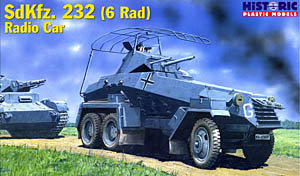Historic Plastic Models' 1/35 Sdkfz. 232 (6 rad) Radio Car | | History As the German Army moved towards the 1930s, a need for a more modern form of armored car became apparent. Initially a custom chassis was tested, but this proved to be too expensive for series production and regular three-axle commercial truck chassis were selected instead. The Daimler Benz G-3 chassis was chosen in 1929 and the SdKfz 231 started to take shape. A welded hull with a rotating turret was mounted on the G-3 chassis. Armament consisted of a single 7.92mm gun. In 1930 an upgrade took place, both in the basic chassis and the armament. The Daimler Benz G-3a as well as the Büssing NAG G-31 and Magirus M-206 were used for the chassis, and the armament was increased to a 20mm cannon and a single MG 13 machine gun. Some of these cars had slightly different armament, the shape to the mudguards, and other small details. The SdKfz. 232 was a further modification, with a large aerial mounted over the hull. 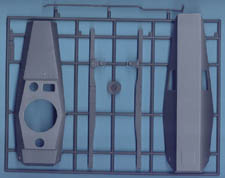 The SdKfz. 231 & 232 were popular vehicles in German military parades before the war, and the vehicles first saw combat in Poland. They soldiered on during the fighting in the Low countries and France, but due to their poor terrain handling capabilities they were soon turned over to training units and probably also saw service in the police capacity. The SdKfz. 231 & 232 were popular vehicles in German military parades before the war, and the vehicles first saw combat in Poland. They soldiered on during the fighting in the Low countries and France, but due to their poor terrain handling capabilities they were soon turned over to training units and probably also saw service in the police capacity.
The Kit This model is based on the Büssing NAG G-31 variant of the SdKfz. 232, although with the proper references it shouldn't be too difficult to modify it into either the G-3a or Magirus M-206 variants. By leaving the radio antenna off you can also build a SdKfz. 231 from this kit. The parts are all molded in a gray plastic and have good detailing with only a hint of flash here and there. A total of seven sprues are provided and a small decal sheet rounds things out. 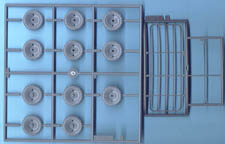 The hull is the main part of this kit and due to its complex shape it has been split into lower and upper halves. Onto the lower hull fits the frame and various bits and pieces to make up the visible portions of the engine & gas tank. The suspension is big, basic, and matches the real thing pretty well. The fenders are molded separately, with scribed lines showing where they go. Boxes fit onto the fenders just about everywhere, with the lids molded separately (although the boxes themselves are solid, so you can't have them displayed open). There's also some closed hatches and access panels that also need to be glued onto the hull, as well as hatches that can be displayed in either open or closed positions. There is no interior detailing, though, so if you want to open those up you'll want to add something inside. The hull is the main part of this kit and due to its complex shape it has been split into lower and upper halves. Onto the lower hull fits the frame and various bits and pieces to make up the visible portions of the engine & gas tank. The suspension is big, basic, and matches the real thing pretty well. The fenders are molded separately, with scribed lines showing where they go. Boxes fit onto the fenders just about everywhere, with the lids molded separately (although the boxes themselves are solid, so you can't have them displayed open). There's also some closed hatches and access panels that also need to be glued onto the hull, as well as hatches that can be displayed in either open or closed positions. There is no interior detailing, though, so if you want to open those up you'll want to add something inside.
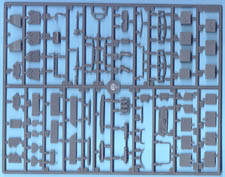 The top part of the hull gets the busy treatment as well, mainly in the form of hatches to glue down. The front end gets the usual lights and such, while the turret area gets driver's windows and other hatches. The turret itself is made up of four main pieces. The commander's hatch in the turret can be displayed open or closed, but again there is no interior provided. The gun barrels are decent, and the instructions show how to add canvas covers should you wish to do so. The radio aerial is the final piece in this kit, and there's a total of eight pieces making up the aerial and the mounts. These parts are thin and likely will need the most cleanup to eliminate mold lines. The top part of the hull gets the busy treatment as well, mainly in the form of hatches to glue down. The front end gets the usual lights and such, while the turret area gets driver's windows and other hatches. The turret itself is made up of four main pieces. The commander's hatch in the turret can be displayed open or closed, but again there is no interior provided. The gun barrels are decent, and the instructions show how to add canvas covers should you wish to do so. The radio aerial is the final piece in this kit, and there's a total of eight pieces making up the aerial and the mounts. These parts are thin and likely will need the most cleanup to eliminate mold lines.
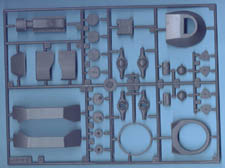 The colors and markings for this kit are fairly straightforward, as most of these remained in their panzer gray finish. There is a comprehensive exterior painting guide showing the basic common colors found on all the choices, leaving the other diagrams to just show decal placement and any special coloration. There's a total of four schemes offered, with the decals making up the basics in the form of crosses & license plates. One is from the Guderian Panzer Group in France, 1940, one from 1. Leichte Division in Poland, 1939, a third from 4. Panzer-Division, also in Poland 1939, and a fourth from before the war, with 4. Aufklärungs Abteilung, 1. Panzer Division, Germany, 1936/37. This last one departs from the overall panzer gray scheme with the addition of irregular blotches of brown all over it. The decals are printed by The colors and markings for this kit are fairly straightforward, as most of these remained in their panzer gray finish. There is a comprehensive exterior painting guide showing the basic common colors found on all the choices, leaving the other diagrams to just show decal placement and any special coloration. There's a total of four schemes offered, with the decals making up the basics in the form of crosses & license plates. One is from the Guderian Panzer Group in France, 1940, one from 1. Leichte Division in Poland, 1939, a third from 4. Panzer-Division, also in Poland 1939, and a fourth from before the war, with 4. Aufklärungs Abteilung, 1. Panzer Division, Germany, 1936/37. This last one departs from the overall panzer gray scheme with the addition of irregular blotches of brown all over it. The decals are printed by 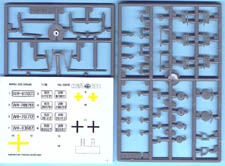 Propagteam and while they're basically simple they are well done and are thin. Propagteam and while they're basically simple they are well done and are thin.
Conclusion While this kit may not have the finesse of a Tamiya kit, the detailing is very good and the assembly straightforward. This will be a fairly simple kit to build and adds an important vehicle to the early Wehrmacht lineup. | 


 




|
